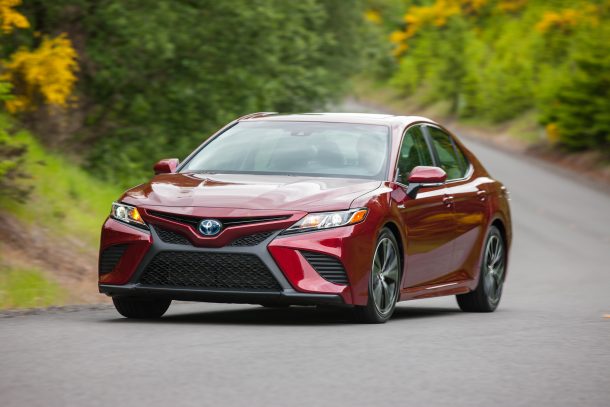July 2018 Midsize Sedan Sales: Toyota Camry Finally Slips Into the Red

Last year’s release of the radically revamped 2018 Toyota Camry lent buoyancy to a model seen as the troubled midsize sedan segment’s most resilient nameplate. It has history, name recognition, and a stigma for no-nonsense comfort and reliability. Could you ask for anything more?
And so, as other sedans, including the equally fresh Honda Accord, started falling away, the Camry retained its sales volume, finishing the first half of 2018 with a slight year-to-date increase. July brought bad news, however. While the Toyota brand performed worse than the industry average last month — sales fell 6 percent, year over year — it was passenger cars that earned the brand its volume loss.
And even the Camry’s partly to blame.
Truth be told, the Camry’s U.S. sales began slipping in March, but the sales lead built up in the preceding months allowed it to coast till summer with a positive, but diminishing, year-to-date figure. July sales figures show that lead gone, replaced by a 2.7 percent YTD loss. The Camry found 22.2 percent fewer buyers last month compared to July 2017.
It looks like the vehicle billed by Toyota as the savior of the midsize segment has joined the club. And it’s in good company.
In July 2018, Honda Accord sales fell 19.3 percent, year-over-year, with volume over the first seven months of the year down 14.5 percent. The Hyundai Sonata doesn’t fare any better — it’s down 10.3 percent for the month and 26.7 percent for the year. Meanwhile, the Ford Fusion, a sedan already slated for execution, found 22.1 percent fewer buyers in July and 19.2 fewer buyers in 2018 as a whole.
It’s a similar story with Nissan’s Altima, a vehicle that sees its own dramatic revamp this fall. Altima sales sank 28.2 percent, year over year, in July, and 17.1 percent over the first seven months of the year. What about the recently refined Mazda 6, you ask? Now boasting available turbocharged power and the mildest of facelifts, Mazda’s midsizer saw its sales drop 36.4 percent in July, pushing its YTD figure into the red (down 5.6 percent).
As General Motors chooses to hold Chevrolet Malibu figures hostage, we’ll skip over that model and focus on the only low-priced midsize to see a year-over-year increase in July: the Kia Optima, which rose 37.6 percent. Granted, Optima sales cooled off in earnest in July of 2017, so last month’s volume isn’t some sort of spike in popularity. Nor can the Optima claim a TYD increase. It’s down 14.6 percent since the New Year.
Despite gains at Volkswagen, buyers weren’t turning out in droves for the Passat. No, they walked past that model in the showroom and went straight for the Tiguan and Atlas. Passat sales fell 22.2 percent in July and 34.6 percent since the start of the year.
None of this should surprise anyone, as it’s a trend that’s continued unabated since midsize sedans hit a post-recession high water mark around 2014. Light trucks are king, rising 4.3 percent across the industry in July. It’s cars that are to blame for the industry’s 3.7 percent deflation last month (overall volume is still up 1.1 percent, year to date), as that broad segment shrunk by 18 percent.
The public’s growing thirst for trucks, crossovers, and SUVs meant passenger car market share hit a new low last month, dropping to just 31 percent of new vehicle sales.
[Image: Toyota, Honda, Kia]

More by Steph Willems
Latest Car Reviews
Read moreLatest Product Reviews
Read moreRecent Comments
- Jalop1991 This is easy. The CX-5 is gawdawful uncomfortable.
- Aaron This is literally my junkyard for my 2001 Chevy Tracker, 1998 Volvo S70, and 2002 Toyota Camry. Glad you could visit!
- Lou_BC Let me see. Humans are fallible. They can be very greedy. Politicians sell to the highest bidder. What could go wrong?
- SPPPP Vibrant color 9 times out of 10 for me. There may be a few shapes that look just right in metallic gray, for example. There are a few nices ones out there. And I like VW "White Silver". But I'd usually prefer a deep red or a vibrant metallic green. Or a bright blue.
- 28-Cars-Later Say it ain't so, so reboot #6* isn't going to change anything?[list=1][*]V4-6-8 and High "Tech" 4100.[/*][*]Front wheel drive sooooo modern.[/*][*]NOrthSTARt.[/*][*]Catera wooooo.[/*][*]ATS all the things.[/*][*]We're *are* your daddy's Tesla. [/*][/list=1]




































Comments
Join the conversation
I've seen a few Model 3's going down the road. If ever there was a lifestyle statement car, aside from the Prius, the Model 3 is it. In the flesh I find nothing exciting about that car. Its as if Tesla is preparing us for our autonomous people pod future. Sigh... Tesla could really use Henrik Fisker and while the Karma was a hybrid it at least made a possible electric future exciting.
No one seems to talk about the ELEPHANT in the room. How hideous the exterior of the Accord looks. It's like 4 cars mashed into one. Front screams charger. Side screams impala and Malibu but with extra dose of ugliness. And rear says sonata. It's a pathetic design. It's asthetics are horrendous